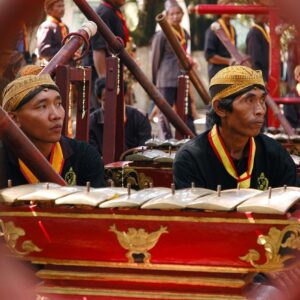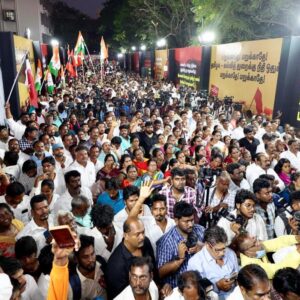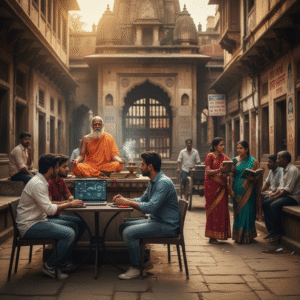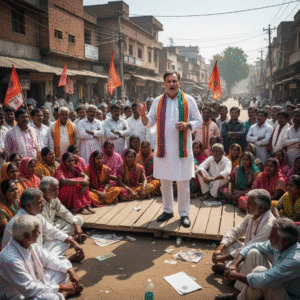Examining the Balance Between Traditional Values and Modern Approaches
Lucknow– Community development in Uttar Pradesh is a multifaceted journey shaped by a blend of traditional philosophies and modern strategies. From the principles ofdharma (duty)in ancient scriptures to Gandhian ideals of self-reliance and decentralized governance, the state’s approach to community well-being reflects its rich cultural and philosophical heritage.
However, as Uttar Pradesh embarks on ambitious development projects and social reforms, questions arise about how these philosophies align with the demands of contemporary society. Are traditional values being integrated into modern strategies, or are they at odds with the rapid pace of change?
Key Metrics Reflecting Community Development in Uttar Pradesh
- Panchayati Raj System: Over 58,000 Gram Panchayats govern rural development across the state, reflecting a decentralized approach (Ministry of Panchayati Raj, 2023).
- Rural Electrification: Uttar Pradesh has achieved 99% village electrification, a significant milestone in improving rural living standards (UP Power Corporation Report, 2023).
- Women Empowerment: Initiatives like Mission Shakti have empowered over 30 million women through education, self-help groups, and financial inclusion (UP Government Report, 2023).
- Economic Development: Programs like One District One Product (ODOP) have generated over 25 lakh jobs, revitalizing traditional crafts and industries (DPIIT Report, 2023).
Traditional Philosophies Guiding Community Development
1. Dharma and Collective Responsibility
The concept ofdharma, emphasizing moral responsibility and harmony, has long been central to Uttar Pradesh’s societal framework.
- Application: Villages in Bundelkhand and Purvanchal continue to practice collective farming and resource sharing, reflecting these ancient principles.
- Modern Relevance: Panchayats, inspired by these values, play a pivotal role in addressing local issues such as water scarcity and sanitation.
2. Gandhian Ideals of Self-Reliance
Mahatma Gandhi’s vision ofGram Swaraj (village self-rule)emphasizes the empowerment of local communities through self-sufficiency and decentralized governance.
- In Action: Rural cooperatives, especially women-led self-help groups, focus on sustainable agriculture, skill development, and financial independence.
- Impact: Regions like Bundelkhand have adopted water conservation practices inspired by Gandhian philosophies to combat recurring droughts.
3. Bhakti and Sufi Traditions of Inclusion
The syncretic Bhakti and Sufi movements in Uttar Pradesh have historically promoted community harmony and equitable resource sharing.
- Legacy: Interfaith initiatives in cities like Bareilly and Amroha emphasize unity and collective growth.
- Cultural Impact: Local festivals and shrines often act as hubs for social interaction and community collaboration.
Modern Approaches to Community Development
1. Government-Led Initiatives
The state government’s focus on infrastructure, education, and healthcare underscores a commitment to improving living standards.
- Examples:
- Mission Shakti has enhanced women’s participation in governance and economic activities.
- The Smart Cities Mission is transforming urban centers like Lucknow and Kanpur into sustainable and efficient hubs.
2. Digital Transformation
Digital literacy and connectivity are reshaping rural communities, enabling access to education, healthcare, and government schemes.
- Progress: Programs like Digi Shakti have distributed over 50 lakh digital devices to students, fostering technological awareness.
- Challenges: Limited internet access in remote areas continues to hinder equitable digital inclusion.
3. Grassroots Movements and NGOs
Non-governmental organizations play a vital role in addressing issues such as sanitation, healthcare, and environmental conservation.
- Case Study: An NGO in Purvanchal has introduced solar-powered water pumps to alleviate irrigation challenges, integrating modern solutions with traditional farming methods.
Philosophical Challenges in Community Development
- Balancing Tradition and Modernity: The integration of traditional values into modern governance often faces resistance due to generational and ideological divides.
- Economic Disparities: Urban-centric development risks sidelining rural communities, perpetuating inequalities.
- Sustainability Concerns: Rapid industrialization and infrastructure projects sometimes conflict with ecological and cultural preservation.
Pathways to Philosophical Harmony in Development
1. Revitalizing Traditional Knowledge
- Integrate indigenous practices such as rainwater harvesting and organic farming into state-led initiatives for sustainable growth.
2. Strengthening Panchayati Raj Institutions
- Empower local governance bodies to address region-specific issues, ensuring community participation in decision-making processes.
3. Promoting Inclusive Policies
- Expand programs like ODOP to encompass more marginalized communities, ensuring equitable economic opportunities.
4. Digital and Cultural Education
- Incorporate teachings from Bhakti and Sufi traditions into digital literacy programs to promote inclusivity alongside technological advancement.
Conclusion
Community development in Uttar Pradesh is a testament to the state’s ability to draw from its philosophical roots while adapting to modern challenges. The blend of traditional wisdom and contemporary strategies offers a unique model for sustainable and inclusive growth.
As Uttar Pradesh continues its journey of transformation, balancing these philosophical perspectives will be key to creating resilient, harmonious, and forward-looking communities across the state.











